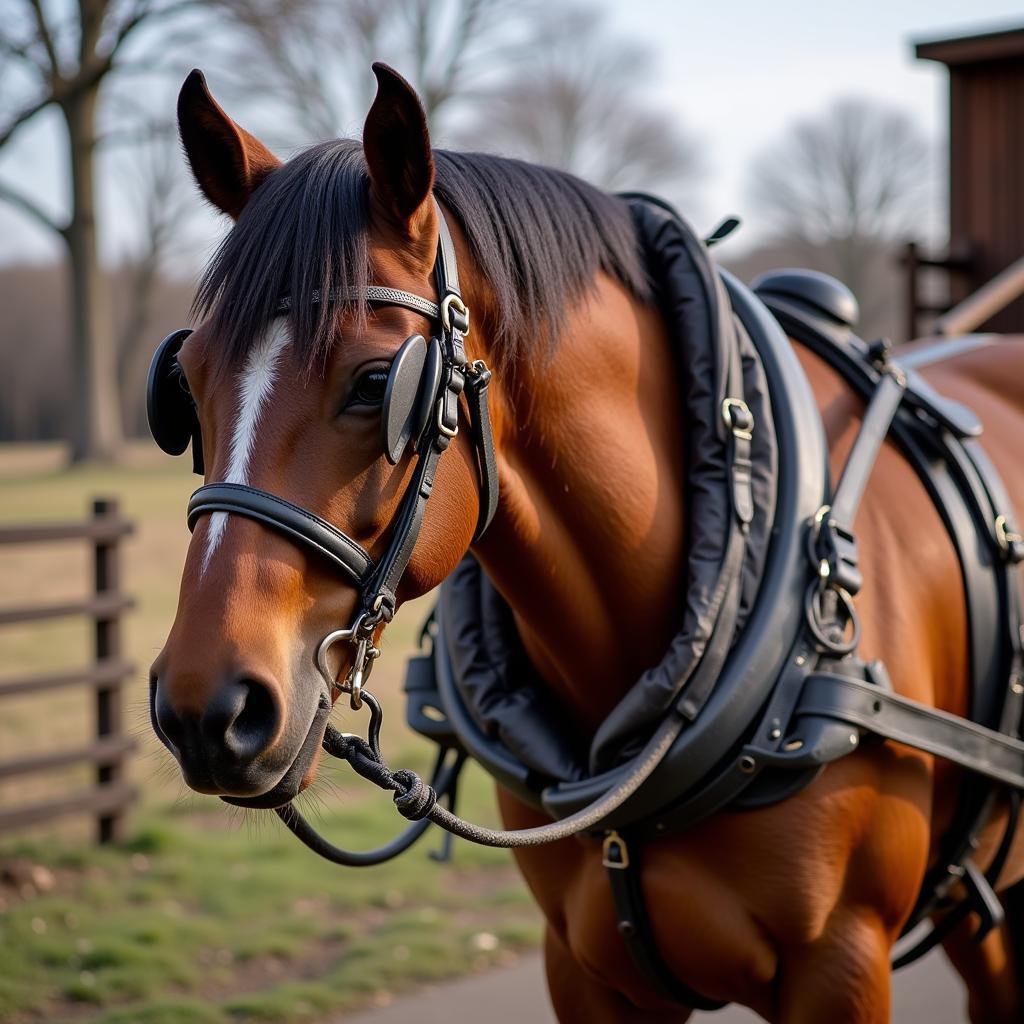A Collar Harness For Horses is an essential piece of equipment for any horse owner looking to hitch their horse to a cart, carriage, or plow. Unlike breast collars that distribute pulling pressure across the chest, a collar harness transfers this force to the horse’s shoulders, making it a more comfortable and efficient option for pulling heavy loads. Choosing the right type of harness, and ensuring it fits correctly, is crucial for your horse’s well-being and performance.
Types of Collar Harnesses
There are several types of collar harnesses designed for different purposes and horse breeds:
-
Full Collar Harness: This is the most common type of harness, suitable for a wide range of activities like plowing, driving, and heavy hauling. It features a large, padded collar that evenly distributes weight across the shoulders and windpipe.
-
Breast Strap Harness: Also known as a buggy harness, this type is lighter than a full collar harness and used for lighter driving activities. It features a breast strap instead of a full collar, making it suitable for horses with sensitive shoulders or those not yet accustomed to pulling heavy loads.
-
Traction Harness: As the name suggests, this harness is specifically designed for heavy pulling activities like logging or draft work. It’s built for strength and durability, often featuring a wider collar and heavier-duty materials.
 Horse Wearing a Full Collar Harness
Horse Wearing a Full Collar Harness
Choosing the Right Collar Harness
Selecting the correct harness for your horse depends on several factors:
-
Horse’s Size and Breed: Draft breeds like Shires and Percherons require larger and sturdier harnesses compared to lighter breeds like Morgans or Arabians.
-
Intended Use: Consider the type of work or activity you’ll be doing. Heavy hauling demands a full collar harness, while recreational driving might suit a breast strap harness.
-
Fit and Comfort: A well-fitted harness is crucial to prevent discomfort and injuries. It should sit comfortably on your horse without pinching, rubbing, or restricting movement.
Fitting a Collar Harness
Properly fitting a collar harness is crucial for your horse’s health and performance. Here’s a step-by-step guide:
-
Collar Fitting: The collar is the most critical part of the harness. It should fit snugly around the horse’s neck, two fingers’ width between the collar and the windpipe.
-
Hames Adjustment: Hames are the wooden or metal pieces that attach the collar to the rest of the harness. They should be adjusted so the collar sits at the correct height on the horse’s shoulders.
-
Traces and Back Band: Traces connect the collar to the vehicle being pulled. They should be adjusted to the appropriate length, ensuring the back band sits comfortably on the horse’s back without slipping forward or backward.
 Measuring a Horse for a Collar Harness
Measuring a Horse for a Collar Harness
Caring for your Horse’s Collar Harness
To ensure your horse’s collar harness remains in top condition and lasts for years, follow these care tips:
-
Regular Cleaning: After each use, clean the harness with saddle soap and water to remove dirt, sweat, and debris.
-
Conditioning: Regularly condition the leather parts of the harness with a leather conditioner to prevent drying and cracking.
-
Storage: Store the harness in a cool, dry place away from direct sunlight and moisture.
Benefits of Using a Collar Harness
Using a properly fitted collar harness offers several advantages:
-
Enhanced Pulling Power: By transferring weight to the shoulders, collar harnesses allow horses to pull heavier loads more efficiently and with less strain.
-
Increased Comfort: The even weight distribution of a collar harness minimizes pressure points and discomfort, allowing your horse to work comfortably for extended periods.
-
Reduced Risk of Injury: A well-fitted collar harness reduces the risk of chafing, sores, and respiratory problems often associated with poorly fitted harnesses.
FAQs about Collar Harnesses for Horses
Q: How do I know if my horse’s collar harness fits correctly?
A: A properly fitted collar should allow you to fit two fingers comfortably between the collar and your horse’s windpipe. The hames should be adjusted so the collar sits correctly on the shoulders, and the traces and back band should be snug but not restrictive.
Q: Can I use a collar harness on any horse breed?
A: While collar harnesses are suitable for most breeds, it’s crucial to choose a harness specifically designed for your horse’s size and the intended use.
Q: What are the signs of a poorly fitted collar harness?
A: Signs of a poor fit include rubbing or sores on the horse’s shoulders, neck, or back, resistance to moving forward, and difficulty breathing.
For horse owners seeking alternative options for riding or light driving, you can explore other resources on our site like “breastplates for horses” or “mini horse carts and harness.” Remember, investing in a high-quality collar harness and ensuring its proper fit is an investment in your horse’s comfort and well-being.
Need Help with Your Horse’s Harness?
Choosing and fitting a collar harness can be a detailed process. If you need assistance selecting the right harness or ensuring a proper fit for your horse, don’t hesitate to contact our team at Justus Horses USA. Our experts are available 24/7 to help you find the best solutions for your equine needs. Reach us at Phone Number: 0772127271, Email: [email protected], or visit our location at QGM2+WX2, Vị Trung, Vị Thuỷ, Hậu Giang, Việt Nam.